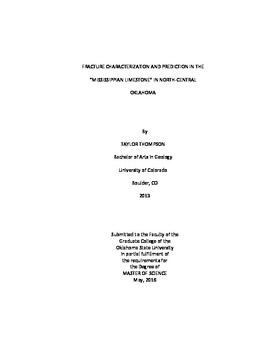| dc.contributor.advisor | Grammer, G. Michael | |
| dc.contributor.author | Thompson, Taylor | |
| dc.date.accessioned | 2017-02-22T22:16:34Z | |
| dc.date.available | 2017-02-22T22:16:34Z | |
| dc.date.issued | 2016-05 | |
| dc.identifier.uri | https://hdl.handle.net/11244/49167 | |
| dc.description.abstract | Unconventional Mississippian oil and gas reservoirs in central and northern Oklahoma and southern Kansas are characterized by porosities of 1-2 percent or less, and permeability values measured in fractions of millidarcies. As such, natural fractures are an important part of reservoir performance in the �Mississippi Lime.� Understanding the types and distribution of fractures in these carbonate rocks and how they may be related to facies and sequence stratigraphic architecture, may increase the predictability of fracture-enhanced permeability in the subsurface. The overall goal of the study is to understand the distribution and types of fractures within the �Mississippian Limestone� as they may relate to specific facies and sequence stratigraphic architecture to increase the subsurface predictability of fracture permeability. Three cores from Payne and Osage counties, Oklahoma were utilized in this study (Elinore #1-18, Winney #1-8, and Orion Blackbird #3-44). Fracture types in the cores were first identified and various fracture properties were measured. This data was integrated with the established high-resolution sequence stratigraphic framework to analyze the distribution of fractures within petrophysically-significant facies. Fracture types and fracture density are facies dependent (i.e. fracture predictability is enhanced by tying the data to the 4 defined facies types). The crinoidal packstone-grainstone facies had the highest number of ptygmatic and vertical extensional fractures and the highest fracture density in the Elinore and Winney cores (1.95 fractures per foot and 1.46 fractures per foot). The glauconitic sandstone facies had the lowest fracture density (0 fractures total). In the Orion core, the bioturbated wackestone-packstone facies had the highest number of ptygmatic and vertical extensional fractures as well as the highest fracture density (2.56 fractures per foot). Fracture types and densities were compared to the sequence stratigraphic framework and XRD data. Fracture type and fracture density correlate to the regressive phases of probable 3rd order high frequency sequences in the Elinore and Winney, suggesting that fracture trends can be predicted by tying the data to the sequence framework. Fracture density did not correlate to the XRD data at high resolutions, but did correlate when the data was averaged by facies type. A more comprehensive dataset would likely yield a more reliable correlation. Micro-CT scanning of fractured samples proved to be a useful tool in evaluating the fracture distribution beyond what can be seen at the surface of the core and highlights the need for analyzing microfractures. | |
| dc.format | application/pdf | |
| dc.language | en_US | |
| dc.rights | Copyright is held by the author who has granted the Oklahoma State University Library the non-exclusive right to share this material in its institutional repository. Contact Digital Library Services at lib-dls@okstate.edu or 405-744-9161 for the permission policy on the use, reproduction or distribution of this material. | |
| dc.title | Fracture characterization and prediction in the “Mississippian limestone” in North-Central Oklahoma | |
| dc.contributor.committeeMember | Puckette, James | |
| dc.contributor.committeeMember | Lao Davila, Daniel | |
| osu.filename | Thompson_okstate_0664M_14480.pdf | |
| osu.accesstype | Open Access | |
| dc.description.department | Geology | |
| dc.type.genre | Thesis | |
| dc.type.material | text | |
